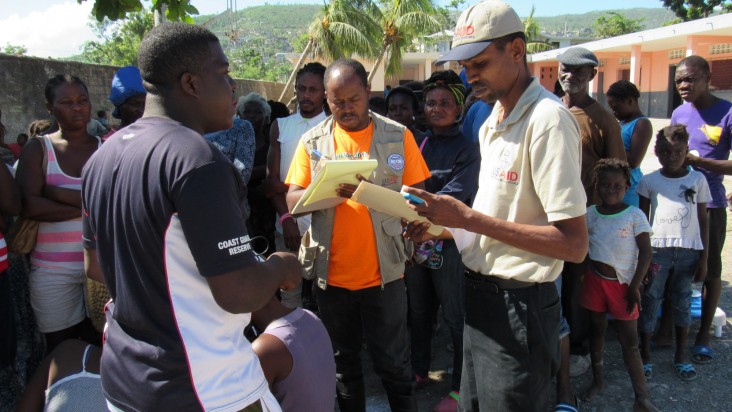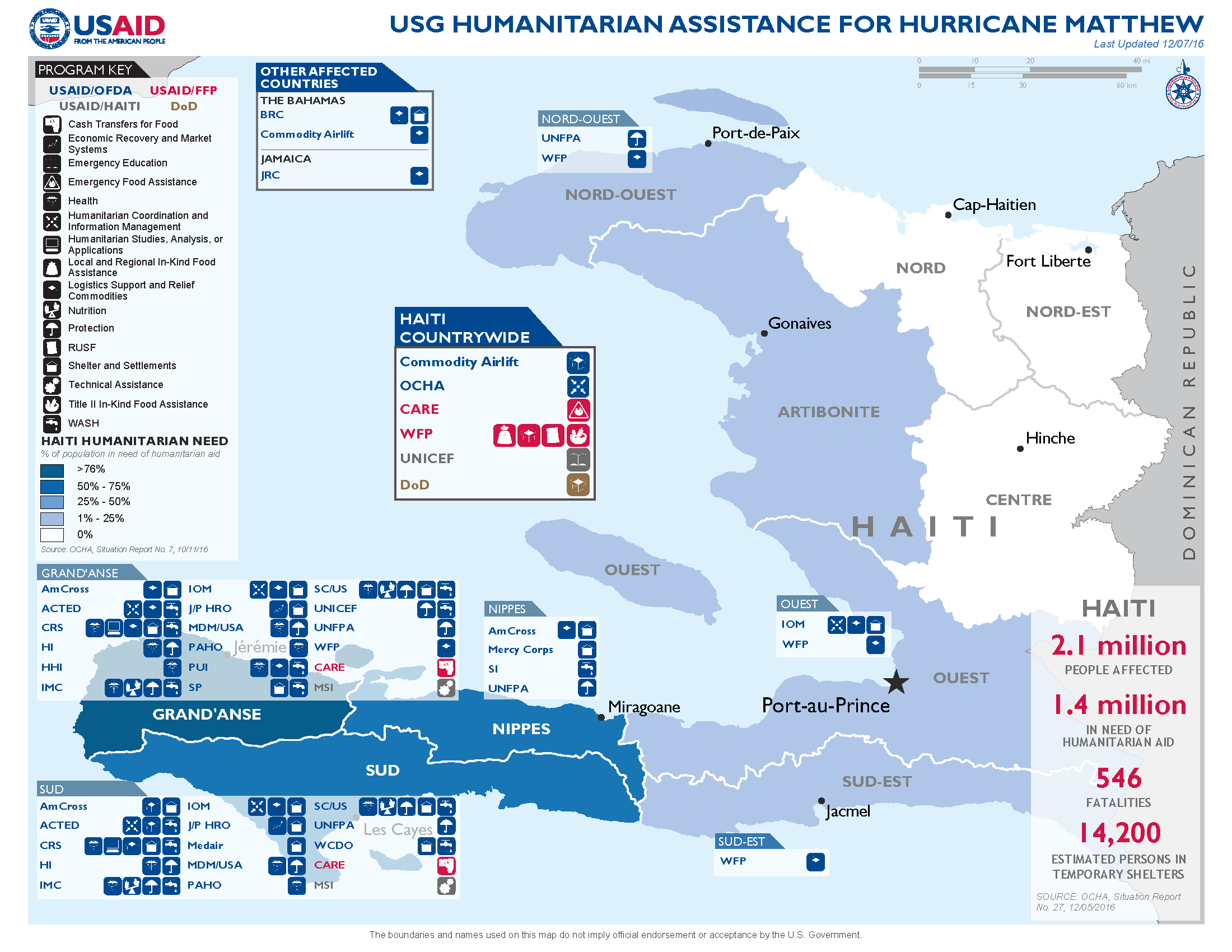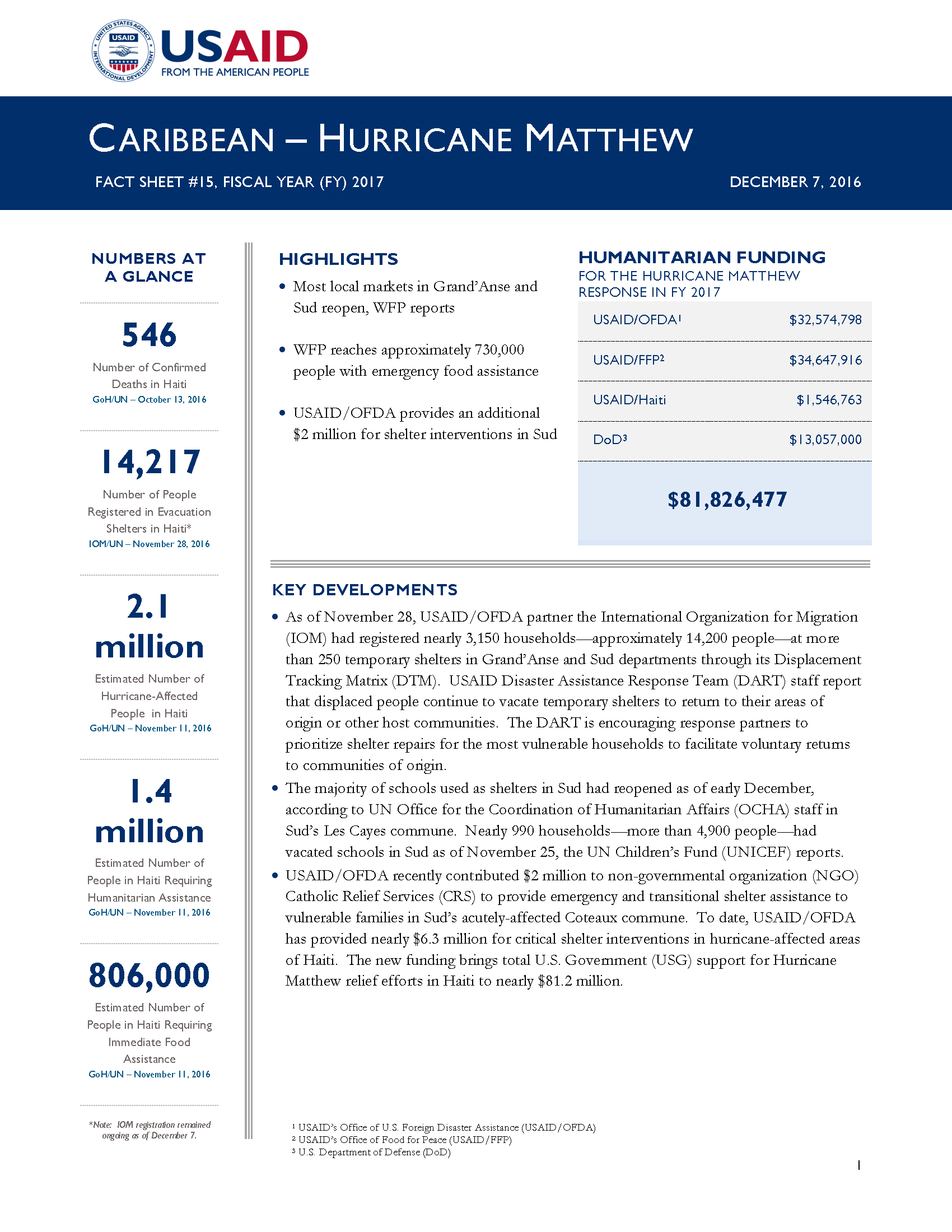December 7, 2016

Highlights
Most local markets in Grand’Anse and Sud reopen, WFP reports.
WFP reaches approximately 730,000 people with emergency food assistance.
USAID/OFDA provides an additional $2 million for shelter interventions in Sud.
Key Developments
As of November 28, USAID/OFDA partner the International Organization for Migration(IOM) had registered nearly 3,150 households—approximately 14,200 people—at more than 250 temporary shelters in Grand’Anse and Sud departments through its Displacement Tracking Matrix (DTM). USAID Disaster Assistance Response Team (DART) staff report that displaced people continue to vacate temporary shelters to return to their areas of origin or other host communities. The DART is encouraging response partners to prioritize shelter repairs for the most vulnerable households to facilitate voluntary returns to communities of origin.
Numbers At A Glance
546
14,217
2.1 million
1.4 million
806,000
Humanitarian Funding
For the Hurricane Matthew Response
in FY 2017
| USAID/OFDA | $32,574,798 |
| USAID/FFP | $34,647,916 |
| USAID/Haiti | $1,546,763 |
| DoD | $13,057,000 |
| TOTAL | $81,826,477 |
As of November 28, USAID/OFDA partner the International Organization for Migration(IOM) had registered nearly 3,150 households—approximately 14,200 people—at more than 250 temporary shelters in Grand’Anse and Sud departments through its Displacement Tracking Matrix (DTM). USAID Disaster Assistance Response Team (DART) staff report that displaced people continue to vacate temporary shelters to return to their areas of origin or other host communities. The DART is encouraging response partners to prioritize shelter repairs for the most vulnerable households to facilitate voluntary returns to communities of origin.
The majority of schools used as shelters in Sud had reopened as of early December,according to UN Office for the Coordination of Humanitarian Affairs (OCHA) staff in Sud’s Les Cayes commune. Nearly 990 households—more than 4,900 people—had vacated schools in Sud as of November 25, the UN Children’s Fund (UNICEF) reports.
USAID/OFDA recently contributed $2 million to non-governmental organization (NGO)Catholic Relief Services (CRS) to provide emergency and transitional shelter assistance to vulnerable families in Sud’s acutely-affected Coteaux commune. To date, USAID/OFDA has provided nearly $6.3 million for critical shelter interventions in hurricane-affected areas of Haiti. The new funding brings total U.S. Government (USG) support for Hurricane Matthew relief efforts in Haiti to nearly $81.2 million.
LOGISTICS SUPPORT AND RELIEF COMMODITIES
On December 1, a UN World Food Program (WFP) fixed-wing aircraft arrived in Haiti’s capital city of Port-au-Prince to increase capacity to transport humanitarian staff from Port-au-Prince to Les Cayes and Grand’Anse’s Jeremie commune. WFP also maintains a barge and two helicopters based in Les Cayes to support the transportation of emergency food assistance and relief items to remote communities in Grand’Anse and Sud. As of November 30, the Logistics Working Group—the coordinating body for humanitarian logistics activities, comprising UN agencies, NGOs, and other stakeholders—had supported the air transportation of more than 1,110 humanitarian personnel and 160 metric tons (MT) of cargo; the road transportation of approximately 545 MT of humanitarian cargo; and the sea transportation of more than 840 MT of cargo. As of November 25, USAID/OFDA airlifted and pre-positioned relief commodities had reached more than 60,940 households—approximately 304,700 people—in Grand’Anse, Nippes, Nord-Ouest, Ouest, Sud, and Sud-Est departments.
EMERGENCY FOOD ASSISTANCE
USAID partner WFP and implementing organizations had delivered approximately 7,800 MT of emergency food assistance to an estimated 730,000 people—approximately 91 percent of the 806,000 people identified as severely food-insecure—in Grand’Anse, Nippes, and Sud as of December 1. Additionally, WFP had provided supplementary food to an estimated 3,130 children ages 6–59 months. WFP aims to reach approximately 800,000 people with a one-month supply of food through first phase food distributions, scheduled to end in mid-December, after which the UN agency plans to provide cash-based transfers in addition to general food distributions.
On November 5, WFP released findings from a late-October market analysis, conducted in coordination with the Government of Haiti (GoH) National Food Security Coordination (CNSA), the GoH Ministry of Agriculture (MoA), USAID/FFP partner CARE, and the USAID-funded Famine Early Warning Systems Network (FEWS NET). Based on key informant interviews, a joint assessment team evaluated the capacity of more than 20 markets in hurricane-affected areas to absorb the increased demand for commodities expected to result from cash-based transfers. The analysis noted that most surveyed markets—with the exception of some particularly hard-hit traders in Grand’Anse—have reopened and are operating at pre-hurricane levels. Most available goods are imported, with limited availability of local food products, including bananas, beans, and yams. The analysis reported that the use of cash-based transfers in hurricane-affected areas is a feasible response activity that can assist with the restoration of household livelihoods, although price fluctuations need to be monitored weekly to ensure that beneficiaries maintain stable purchasing power.
With more than $14.4 million from USAID/FFP, a CARE-led NGO consortium—including the Agency for Technical Cooperation and Development (ACTED), CRS, Food for the Hungry, and Mercy Corps—plans to provide cash-based transfers to an additional 500,000 people in Grand’Anse’s Abricots, Chambellan, Dame-Marie, and Les Irois communes, as well as Sud’s Cavaillon, Chantal, Chardonnieres, and Port-à-Piment communes. After an initial distribution of unconditional cash assistance, CARE and partners intend to transition to cash-for-work activities that will assist approximately 98,000 beneficiaries, thereby increasing vulnerable households’ access to food, while restoring community assets damaged by the hurricane.
HEALTH AND WASH
Response actors continue to support cholera prevention and treatment efforts in the aftermath of Hurricane Matthew. The GoH Ministry of Public Health and Population (MSPP) reported approximately 310 new suspected cholera cases in Grand’Anse and Sud between November 20 and 26—a decrease from the 440 cases reported the previous week. As of late November, MSPP data indicated that suspected case counts were lower than during the initial weeks following Hurricane Matthew.
U.S. Centers for Disease Control and Prevention (CDC) staff continue to support MSPP to perform cholera-related epidemiology and surveillance efforts, including case investigation, specimen collection and testing, and training for laboratory technicians in Les Cayes and Port-au-Prince.
To prevent and treat cholera and other waterborne illnesses, USAID/OFDA has provided more than $8.2 million to date for the provision of primary health care, cholera treatment, and water, sanitation, and hygiene (WASH) services in hurricane-affected areas. As of late November, USAID/OFDA partners had established 19 mobile clinics, 12 oral rehydration points, and five cholera treatment facilities in Grand’Anse and Sud. Additionally, USAID/OFDA has provided approximately 5.7 million water purification tablets and supported GoH-led bulk chlorination of water systems, facilitating access to safe drinking water for an estimated 280,000 people in Grand’Anse, Nippes, and Sud.
SHELTER AND SETTLEMENTS
As of November 28, the IOM DTM had registered nearly 3,150 households—approximately 14,200 people—at more than 250 temporary shelters in Grand’Anse and Sud. DART staff report that displaced people continue to vacate temporary shelters to return to their areas of origin or other host communities. The DART is encouraging response partners to prioritize shelter repairs for the most vulnerable households to facilitate voluntary returns to communities of origin.
The majority of schools used as shelters in Sud had reopened as of early December, according to OCHA staff in Les Cayes. Nearly 990 households—more than 4,900 people—had vacated schools in Sud as of November 25, the UN Children’s Fund (UNICEF) reports.
USAID/OFDA partner J/P Haitian Relief Organization (J/P HRO) continues to support the return and resettlement of displaced populations in Jeremie commune’s Jeremie town. As of December 6, J/P HRO had helped to facilitate the voluntary return of approximately 75 households from Jeremie’s École des Soeurs Marguerite D’youville—identified by local authorities as a priority shelter for evacuation—to their communities of origin.
During the week of November 28, USAID/OFDA partner Save the Children/U.S. (SC/US) provided approximately 450 households with emergency shelter assistance, including plastic sheeting and shelter kits, as well as technical guidance on shelter repairs. To date, SC/US has reached more than 3,000 households—approximately 15,000 people—in Grand’Anse and Sud with emergency shelter support.
USAID/OFDA recently provided an additional $2 million to CRS to provide emergency and transitional shelter assistance in hurricane-affected Coteaux. The new funding brings USAID/OFDA’s assistance to address the acute and transitional shelter needs of hurricane-affected populations, including those displaced to temporary shelters and host communities, to nearly $6.3 million. As of late November, response actors had distributed more than 4,300 rolls of USAID/OFDA-procured plastic sheeting—sufficient to meet the emergency shelter needs of approximately 216,200 people—to hard-hit communities in Grand’Anse, Nippes, Nord-Ouest, Ouest, Sud, and Sud-Est, according to IOM. USAID/OFDA is also coordinating with USAID/Haiti on longer-term shelter programming as relief actors prepare to transition from emergency response to early recovery interventions.
HUMANITARIAN COORDINATION AND INFORMATION MANAGEMENT
Following a November 30 UN Humanitarian Country Team meeting in Les Cayes, response actors have outlined a plan to address the critical needs of the most vulnerable hurricane-affected populations. The plan—which will reorient existing returns task forces in Jeremie and Les Cayes to assist returnees and other affected households—prioritizes assistance for the most vulnerable individuals in hurricane-affected areas, including through household-level multi-sector needs assessments. As of early December, USAID/OFDA partner ACTED was piloting household vulnerability assesments, developed in coordination with the UN Population Fund (UNFPA), in temporary shelters in Port-à-Piment. Through the departmental emergency operations centers in Jeremie and Les Cayes, inter-sector coordination groups, in collaboration with local authorities, aim to implement the plan in Grand’Anse and Sud in the coming weeks.
OTHER HUMANITARIAN ASSISTANCE
In late November, OCHA released a revised flash appeal to reflect both delivered humanitarian assistance and the outstanding critical needs of hurricane-affected people in Haiti. The revised appeal requests a total of $139 million—an increase of approximately $19 million—and seeks to provide emergency food assistance to 806,000 people; emergency relief commodities to 805,000 people; and health and WASH assistance to 750,000 people, among other interventions. As of December 7, international donors had contributed nearly $67 million—approximately 48 percent of the requested total—toward the revised flash appeal, according to the OCHA Financial Tracking Service.
CONTEXT
Hurricane Matthew made initial landfall near Les Anglais, Haiti, and secondary landfall over eastern Cuba on October 4 before continuing to traverse The Bahamas from October 5–7. The hurricane brought destructive winds, heavy rainfall, and dangerous storm surge, resulting in extensive damage to crops, houses, and infrastructure, as well as widespread flooding in some areas.
On October 2, U.S. Ambassador to Haiti Peter F. Mulrean and U.S. Chargé d’Affaires, a.i., for Jamaica Eric Khant issued disaster declarations in response to the anticipated effects of Hurricane Matthew. U.S. Chargé d’Affaires, a.i., Lisa A. Johnson issued a disaster declaration in response to the anticipated effects of Hurricane Matthew in The Bahamas on October 4.
USAID activated a regional DART on October 3 with staff in The Bahamas, Haiti, and Jamaica. USAID also stood up a Washington, D.C.-based Response Management Team to coordinate the regional humanitarian response.
Based on assessment findings and in consultation with government representatives in the two countries, USAID discontinued DART operations in Jamaica and The Bahamas on October 5 and 13, respectively. USAID/OFDA regional staff will continue to monitor USAID/OFDA assistance provided to the Bahamas Red Cross (BRC) and the Jamaica Red Cross (JRC) to address the immediate needs of populations affected by Hurricane Matthew.









Comment
Make a general inquiry or suggest an improvement.